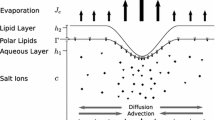Abstract
The tear film that coats the ocular surface is the major refractive surface of the visual system [1, 2]. It impacts the quality of the retinal image by changing its homogeneity. The tear film composition changes in different status. The behavior of the tear film is dynamic between each blink; it evenly coats the ocular surface immediately after a blink to form a smooth optical interface; the tear film gradually becomes unstable in an interblink interval; and local thinning or interruption of the tear film will lead to optical distortion and scatter [3]. Nonuniform distribution of the tear film will increase intraocular aberrations and scatter, which affects the visual quality of the eye and often manifests as vision fluctuations or blurred vision in the clinic [4–7].
Access this chapter
Tax calculation will be finalised at checkout
Purchases are for personal use only
Similar content being viewed by others
References
Gipson IK. The ocular surface: the challenge to enable and protect vision: the Friedenwald lecture. Invest Ophthalmol Vis Sci. 2007;48(10):4390–8.
Tutt R, Bradley A, Begley C, et al. Optical and visual impact of tear break-up in human eyes. Invest Ophthalmol Vis Sci. 2000;41(13):4117–23.
Szczesna DH, Iskander DR. Lateral shearing interferometry for analysis of tear film surface kinetics. Optom Vis Sci. 2010;87(7):513–7.
Montes-Mico R, Alio JL, Munoz G, Charman WN. Temporal changes in optical quality of air-tear film interface at anterior cornea after blink. Invest Ophthalmol Vis Sci. 2004;45(6):1752–7.
Himebaugh NL, Nam J, Bradley A, Liu H, Thibos LN, Begley CG. Scale and spatial distribution of aberrations associated with tear breakup. Optom Vis Sci. 2012;89(11):1590–600.
Denoyer A, Rabut G, Baudouin C. Tear film aberration dynamics and vision-related quality of life in patients with dry eye disease. Ophthalmology. 2012;119(9):1811–8.
Koh S, Maeda N, Kuroda T, et al. Effect of tear film break-up on higher-order aberrations measured with wavefront sensor. Am J Ophthalmol. 2002;134(1):115–7.
Craig JP, Nichols KK, Akpek EK, Caffery B, Dua HS, Joo CK, Liu Z, Nelson JD, Nichols JJ, Tsubota K, et al. TFOS DEWS II definition and classification report. Ocul Surf. 2017;15(3):276–83.
Fiona S, Monica A, Bunya Vatinee Y, et al. TFOS DEWS ii epidemiology report. Ocul Surf. 2017;15(3):334–65.
Diaz-Douton F, Benito A, Pujol J, et al. Comparison of the retinal image quality with a Hartmann-Shack wavefront sensor and a double-pass instrument. Invest Ophthalmol Vis Sci. 2006;47(4):1710–6.
Janine S, Nichols Kelly K, Baldwin Edward K. Current patterns in the use of diagnostic tests in dry eye evaluation. Cornea. 2008;27(6):656–62.
Lemp Michael A, Bron Anthony J, Christophe B, et al. Tear osmolarity in the diagnosis and management of dry eye disease. Am J Ophthalmol. 2011;151(5):792–798.e1.
Szczesna Dorota H, David A-C, Robert ID, et al. Lateral shearing interferometry, dynamic wavefront sensing, and high-speed videokeratoscopy for noninvasive assessment of tear film surface characteristics: a comparative study. J Biomed Opt. 2010;15(3):037005.
Benito A, Perez GM, Mirabet S, et al. Objective optical assessment of tear-film quality dynamics in normal and mildly symptomatic dry eyes. J Cataract Refract Surg. 2011;37(8):1481–7.
Diaz-Valle D, Arriola-Villalobos P, García-Vidal SE, et al. Effect of lubricating eyedrops on ocular light scattering as a measure of vision quality in patients with dry eye. J Cataract Refract Surg. 2012;38(7):1192–7.
Yu AY, Lu T, Pan AP, et al. Assessment of tear film optical quality dynamics. Invest Ophthalmol Vis Sci. 2016;57(8):3821–7.
Ryohei N, Kazunori M, Tatsuro T, et al. Corneal barrier function, tear film stability, and corneal sensation after photorefractive keratectomy and laser in situ keratomileusis. Am J Ophthalmol. 2005;139(1):64–71.
Eun HK, Chul YS, Min AJ, et al. Evaluation of dry eye and meibomian gland dysfunction after cataract surgery. Am J Ophthalmol. 2014;157(6):1144–1150.e1.
Gomes José Alvaro P, Azar Dimitri T, Christophe B, et al. TFOS DEWS II iatrogenic report. Ocul Surf. 2017;15(3):511–38.
Tan CH, Labbe A, Liang Q, et al. Dynamic change of optical quality in patients with dry eye disease. Invest Ophthalmol Vis Sci. 2015;56(5):2848–54.
Author information
Authors and Affiliations
Editor information
Editors and Affiliations
Rights and permissions
Copyright information
© 2021 People's Medical Publishing House, PR of China
About this chapter
Cite this chapter
Qiao, LY. (2021). Clinical Application of Tear Film Analysis. In: Yu, AY. (eds) Double-pass Optical Quality Analysis for the Clinical Practice of Cataract. Springer, Singapore. https://doi.org/10.1007/978-981-16-0435-5_5
Download citation
DOI: https://doi.org/10.1007/978-981-16-0435-5_5
Published:
Publisher Name: Springer, Singapore
Print ISBN: 978-981-16-0434-8
Online ISBN: 978-981-16-0435-5
eBook Packages: MedicineMedicine (R0)




